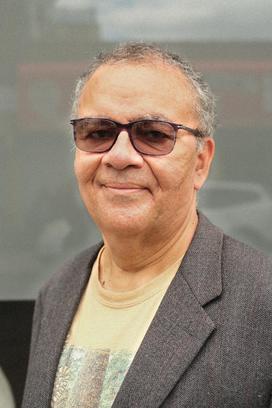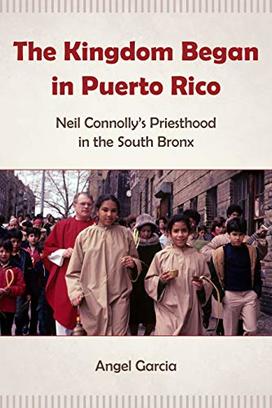Angel Garcia ’79 Recounts Rev. Neil Connolly’s Work in South Bronx

The Kingdom Began in Puerto Rico: Neil Connolly’s Priesthood in the South Bronx (Fordham University Press) tells a tale of community engagement and the power of service to one’s neighbors. Ultimately Garcia argues that urban policies should reflect this ethos, that direct engagement with the people should be the first and most important consideration in any effort to support a community.

The author: Angel Garcia was a community organizer and Executive Director of South Bronx People for Change, a Church-based direct action and membership organization co-founded by Rev. Connolly. Born in Puerto Rico, and a graduate of Regis High School, Princeton University, and Pace University, Garcia is a longtime resident of the South Bronx and has been active on social justice issues and worker cooperatives.
Opening lines: “So, I am not a writer by trade, and some have accused me of not being a good storyteller. But some years ago I read Howard Zinn’s A People’s History of the United States (highly recommended, in order to see that the little people in all corners of the country have not just sat and accepted injustice), and I thought that it would be so good to have a “people’s history of the South Bronx.” I wanted to share some of the stories of good South Bronx organizing efforts, as told through the leaders involved in them while it was becoming “the South Bronx”—a designation that is only around fifty years old, despite the far longer history of human settlement in the area. My feeling was that these efforts were missing from the history books on the South Bronx and on urban history in general. Since Father Neil Connolly had been involved in founding a social action organization I worked in, I thought, OK, I will start with Neil Connolly. That should be easy, I thought.
Hah.
Neil Connolly, I discovered, was a history of the South Bronx all on his own, given all the initiatives and projects for community and justice he was involved in over the years, so I decided I would focus on him and see what happened. What I found out, as I explored his story over the course of six years, is that a lot of growth happened to this person while he was in his South Bronx era. (A very good story of his Lower East Side era, just as long a period of time, would be well worth telling, too, and may be in the works).
I got to know Neil Connolly while I was an organizer at South Bronx People for Change. I had the great benefit of becoming part of this organization because my mother told me, just months after I graduated college, to stop whining about things like “Oh, where is community?” and “I want a sense of community” and, instead, join up with the local Social Action Committee at St. Anselm’s parish. I was told by my mother to put my money where my mouth is. Since the committee was meeting in the building next door to ours, I had no excuse for not attending.
I fell in love with these concepts of social justice, social action, and organizing that drove this group, and I found my community there—first as a volunteer, then as a staff member, and finally, after a couple of staff and life changes, I became the executive director by default.
Suffice it to say that, as far as organizing or directing, I did not really know my elbow from a hole in the ground. (Ivy League education teaches you only so much, and I wasn’t even very good at that.) But I really got into the organizing with the guidance of others, including the chairman of the board, Neil Connolly, who kept coming in, sitting down, and meeting with me and recommending a solution, or, if he didn’t have one, talking to someone who could. He brought a great deal of optimism to those meetings.
Then we moved on, as people do. But my contact with Neil Connolly continued, and years later, we reconnected in a more in-depth way. Simply put, it began when he made an offer I couldn’t refuse.
At his request, I joined his board of directors for Grand Street Guild, an affordable housing organization sponsored by St. Mary’s parish in the mid-1970s, and in the process I found out that he was up to quite a bit in his new community on the Lower East Side. As pastor at St. Mary’s, Neil Connolly was automatically chairman of the board, per the Guild’s bylaws. He was putting together a panel of new members who were “experts,” and he called on me. (Business degree. Don’t ask.)
I have to admit, I really, really did not want to join any boards at the time, but again, Neil Connolly was asking, and I couldn’t refuse him. He had always been there for me, and I felt I should be there for him. He had helped me years earlier, at a time when I was still growing up, figuring out how to solve problems, and learning how to build an organization. An overwhelming time, sometimes. Okay, often.
I came to appreciate that Neil gave, and asked others to give, so that we could have a community of giving. That’s the way things should work in this world, according to Neil Connolly. And the increased interaction gave me an opportunity to find out about his experiences and his evolving views of his priesthood in the South Bronx, one after another. So I have tried to capture some of them here.
The other thing I discovered, in approaching the writing of this book, is that there were always two arenas that Neil Connolly was relating to in his South Bronx era: the Church and the world. It complicated things when I was writing about his growth as a priest, because this took place in a historical context, and there are two histories: one of the Church—mostly the Archdiocese of New York, sometimes driven by events of the Church in the United States, and sometimes by those in the global Church—and another of the world, the secular context in which his priesthood was unfolding. Following his story, and placing him in those two arenas in a historically fair manner, was a big challenge. But it became important to me because his learning to grow in both arenas, I concluded, was important to him.”
Review: “The Kingdom Began in Puerto Rico is an engaging study of the dedicated and charismatic Irish-American priest of the archdiocese of New York and the vicar of the South Bronx, Father Neil Connolly, who was widely respected, far beyond the confines of his own faith community, for his efforts in the poorest congressional district in the United States. Pope Francis would have been proud of him because he shared Francis’s values and priorities, especially his commitment to the poor. Angel Garcia offers here a valuable introduction to the role of the Catholic Church in the survival and revival of the South Bronx.” — Msgr. Thomas J. Shelley, Emeritus Professor of Church History at Fordham University











No responses yet